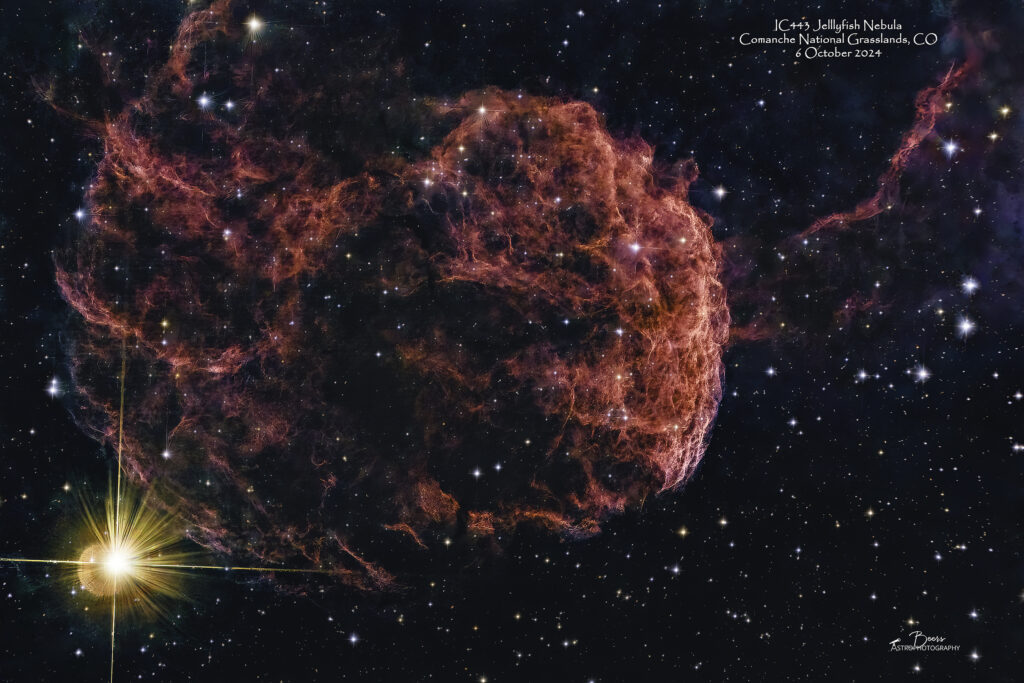
Target Fun Facts
IC 443 (also known as the Jellyfish Nebula and Sharpless 248 (Sh2-248)) is a galactic supernova remnant (SNR) in the constellation Gemini. On the plane of the sky, it is located near the star Eta Geminorum. Its distance is roughly 5,000 light years from Earth.
IC 443 may be the remains of a supernova that occurred 3,000 – 30,000 years ago. The same supernova event likely created the neutron star CXOU J061705.3+222127, the collapsed remnant of the stellar core. IC 443 is one of the best-studied cases of supernova remnants interacting with surrounding molecular clouds.
IC 443 is an extended source, having an angular diameter of 50 arcmin (by comparison, the full moon is 30 arcmin across). At the estimated distance of 5,000 light years (1,500 parsec) from Earth, it corresponds to a physical size of roughly 70 light years (20 parsec).
Distance: 5000 light years
Apparent dimensions: 50’ x 40’
Diameter: 70 light year
Constellation: Gemini
Other Designations: IC443, SH2-248, LBN844 PGC2817561, Ced73, SNR G189.0+03.0
{From https://en.wikipedia.org/wiki/IC_443 and Stellarium}
Capture & Processing Notes
IC443 Jellyfish Nebula was the second target for Big Bertha on our second night at the Comanche National Grasslands Camel Rock camping site during our October dark skies trip.
I’d learned my lesson from multiple attempts to let SGP dictate the camera angle on this DSO, so I set up the sequence to not include “rotate to target” during plate solving. I captured the light frames from the SH2-86/NGC6820 Vulpecula nebulous region’s zero-degree angle, before changing to the 135° required by the IC443 Jellyfish framing. I was able to validate the framing with the bright star that I know is in the SW or NE corner of the image when it is framed correctly – which worked like a charm with the camera angle manually set (using my masking tape marking system along the diameter of the camera) prior to the start of the sequence.
The whole process of capturing light frames, reorienting the camera, and starting up the sequence took about 20 minutes (00:43 – 01:05) and the data collection went flawlessly (with great autoguiding performance) throughout the night until I terminated the sequence at astronomical twilight.
Sequence Plan (6Oct2024): Gain: 158, Temp: -0°C, offset=30. 55x300sec. Total: 275 minutes (4:35hrs). Captured 7Oct2024, 01:05MDT – 7Oct2024, 05:54MDT.
Processing: Captured in SGP, stacked in APP (Adaptive Airy Disc), star removal with Starnet++, processing with LR/PS
Equipment
All equipment controlled by HP Probook running Sequence Generator Pro v4.4.1.1441.
- Imaging (ASI2400-BB-FF): ZWO ASI2400MC imaging camera on (Big Bertha) Orion 8″ f/8 Ritchey-Chretien Astrograph Telescope, Teleskop Service Flattener 1.0x for RC Telescopes (TS-RCFLAT2)
- Autofocuser: ZWO EAF Electronic Automatic Focuser (EAF-5V-STD) Assembled the autofocuser, but it was not making enough contact with the focuser knob to operate properly, did without through the night.
- Mount: Rainbow Astro RST-300 (controlled by iHubo ASCOM driver)
- Polar alignment: QHYCCD camera (controlled by Polemaster for polar alignment)
- Autoguiding: Orion 60mm Multi-Use Guide Scope with Orion StarShoot AutoGuider Pro Mono Astrophotography Camera (controlled by PHD2)
Summary
Captured: 6 October 2024; Gain: 158, Temp: -0°C, offset=30. 55x300sec. Total data capture: 4:35 hours
Shooting location: Comanche National Grasslands’ Camel Rock, Colorado
Equipment: Big Bertha (on RST-300 mount)
Processing: Captured in SGP, stacked in APP (Adaptive Airy Disc), star removal with Starnet++, processing with LR/PS
Other images of IC443 Jellyfish Nebula
Multi-session (5) image with data captured from dark skies and HCH: 2022-2024
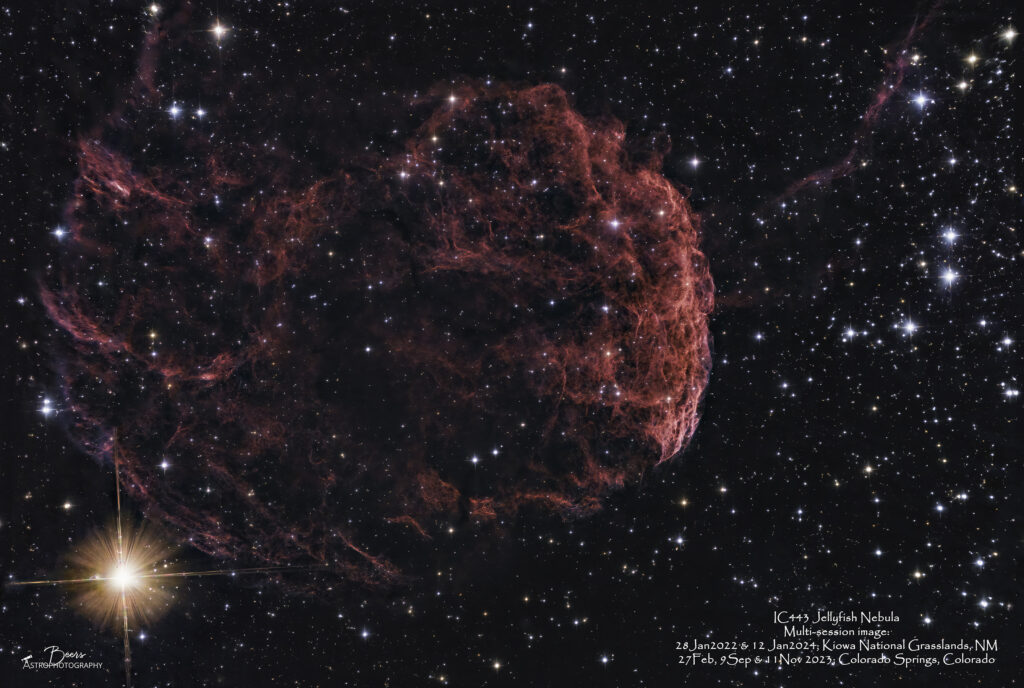
Capture & Processing Notes
In keeping with the trend I started in 2023 of creating images by stacking multiple session’s data, this image is comprised of data captured during five separate imaging sessions. The sessions were in 2022 on 28Jan2022 with Big Bertha and the Canon EOS Ra (RaBB) in the dark skies of the Kiowa National Grasslands, NM. In 2023 on 7Feb2023 with the ZWO ASI2400MC, Big Zeus, and the LeX filter; 9Sep2023 ZWO ASI2400MC, Big Bertha, and the LeX filter; and 11Nov2023 with the ZWO ASI2400MC, Big Bertha, and the LPro filter. All the 2023 session were captured from HCH, Colorado Springs, CO. In 2024 on 12Jan2024 with Big Bertha on the RST-300mount and the ASI2400MC captured from the Kiowa National Grasslands’ Mills Canyon Rim Campground, NM.
After processing the 12Jan2024 data and being relatively happy with it, I couldn’t help but wonder what the result would look like if I combined all my existing data on IC443. Further, I decided I would run a “stacking experiment. First, stacking in APP as usual – with all five sessions creating a single image – and then using Ann Chavtur’s method of Combining RGB in APP to create an RGBHOO image.
The stacking “experiment” consisted of images created in APP:
- 5session: Stacked all five sessions into a single image, using AAD algorithm, saved (to process by itself and use as RGB in combine tool)
- 3session: Stacked Kiowa and LPro sessions into a single image, using AAD algorithm, removed LP and saved (to process by itself (didn’t (yet!) and to use as RGB in Combine)
- 2session: Stacked LeX sessions into a single image, using HaOIII Color algorithm. Reran with HaExtract and OIIIExtract for Ha and OIII in RGBHOO Combine (was actually 3 sessions, because used both 5min and 10min from 7Feb2023 as separate sessions)
- 5session RGBHOO: Then closed and restarted APP and loaded the .FITS files to combine as light frames. Registered the .FITS files (deselect same camera and optics). Ran APP RGB Combine Tool (RGBHOO)
- Load 5session into RGB; Load 3session into RGB; Load 2session HaExtract into Hydrogen Alpha; Load 2session OIIIExtract into OIII (twice)
After finishing the APP stack/combine process, I removed the stars using Starnet++ and was then faced with the challenge of deciding which image to process. I had a very hard time seeing/deciding upon the differences between the stacking methods – there were visible differences, but mostly in the overall tone, not in the details or colors of the image. When I focused on the difference between the 5-session stack and the same data used with the RGBHOO Combine Tool it seems as if the RGBHOO has more of a green tone and less brightness, whereas the 5-session stack (all stacked as I’ve normally done) has a blue tone and a slightly more brightness. So, I decided to move forward with processing the 5-session stack using my normal stacking process.
(Individual sequences’ capture notes and equipment information are listed below in “other images”)
Sequence Plans:
- Kiowa RaBB (28Jan2022): ISO1600; 50x5min + 10x2min (for Propus). Total exposure time: 4:30hrs. Captured, 28Jan2022 1918MST – 29Jan2022, 0011MST.
- HCH ASI2400MC#1 (First Light) BZ LeX (7Feb2023): Gain: 158, Temp: -0°C, no offset. 30x5min, 22x10min. Total exposure time: 6:10hrs. Captured 7Feb2023, 1927MST – 8Feb2023, 0128MST. (Only included the 5min exposures)
- HCH ASI2400MC#2 BB LeX (9Sep2023): Gain: 158, Temp: -0°C, offset=30; 19x5min. Total exposure time: 1:35hrs. Captured 9 September 2023 (10Sep2023, 0409MDT – 00547MDT).
- HCH ASI2400MC#2 BB LeX (11Nov2023): Gain: 158, Temp: -0°C, offset=30; 80x5min. Total exposure time: 6:40hrs. Captured 11 November 2023 (11Nov23, 2208MST – 12Nov23).
- Kiowa ASI2400BB (12Jan2024): Gain 158, Offset 30, Temp 0°C; 69x3min. Captured 12Jan2024, 1901MST – 2304MST. Total exposure time: 3:27hrs.
Total data included in image: 179x5min + 69x3min = 1102min (18:22hrs)
“Wide angle” image with the Southern Cross

Capture & Processing Notes
True to Mother Nature’s latest form, we had a string of clear nights – during and immediately following the full moon! Thank goodness for the LeXtreme light pollution filter! I decided to take advantage of the clear nights to run a couple of experiments ahead of the (rapidly) approaching trip to Chile. First, I wanted to assemble the Southern Cross to make sure that I had everything I need for the trip packed. Second, I wanted to run everything (laptop, camera, mount) from the DC battery for a full night of imaging to make sure I didn’t run into the same problem I ran into during the Mills Rim trip with the RST-300 mount.
Both experiments ended well. The packing experiment revealed that I had everything in its place, except the level, the stakes and hammer for the tripod legs, and the cable for the auto guider (which I had “borrowed” from the Southern Cross’ auto guide camera when I thought that was the problem while we were at Mills Rim earlier in the month). The power experiment revealed that although the battery power was at 11.5V at the end of approximately eleven hours that is enough to run the RST-135E, camera, and laptop without issue.
This was “first light” with the ZWO EAF auto focuser on the the Southern Cross. It worked well, although I think I’ll change the SGPro focusing algorithm from 9x10second focusing images to 7x10second focusing images. It seems that when SGPro drew the parabola for the optimal focusing point, it would have been better if the first and last image hadn’t been included (or if it drew two straight lines instead of the parabola – but no one asked my opinion when they developed the algorithm).
Equipment
All equipment controlled by HP Probook running Sequence Generator Pro v4.2.0.1305.
- Imaging (ASI2400-BB-FF): ZWO ASI2400MC imaging camera with Optolong LeXtreme light pollution filter; (Southern Cross) Askar FRA600 108mm f/5.6 Quintuplet Petzval Flat-Field Astrograph.
- Mount: Rainbow Astro RST-135E (controlled by iHubo ASCOM driver)
- Polar alignment: QHYCCD camera (controlled by Polemaster for polar alignment)
- Autoguiding: Orion 60mm Multi-Use Guide Scope with Orion StarShoot AutoGuider Pro Mono Astrophotography Camera (controlled by PHD2)
Sequence Plan
Gain 158, Offset 30, Temp 0°C; 78x5min. Captured 27Jan2024, 1907MST – 28Jan2024, 0225MST. Total exposure time: 6:30hrs.
Processing
I used my standard processing workflow – stacked in APP using the HaOIII Color algorithm; removed stars with Starnet++ v2; and did the remainder of the processing in Lightroom and Photoshop. The one thing that I experimented with was Photoshop’s Selective Color Adjustment. I’d seen a YouTube video last week by f64 Academy (https://www.youtube.com/watch?v=wYz1d5CK56Q) on “Selective Color for Better Tones,” so I decided to give it a try. It didn’t have tremendous effect on this image, but did seem to make some subtle changes that I’ll likely continue to experiment with in the future.
Dark skies image from Kiowa National Grasslands, NM; 12Jan2024
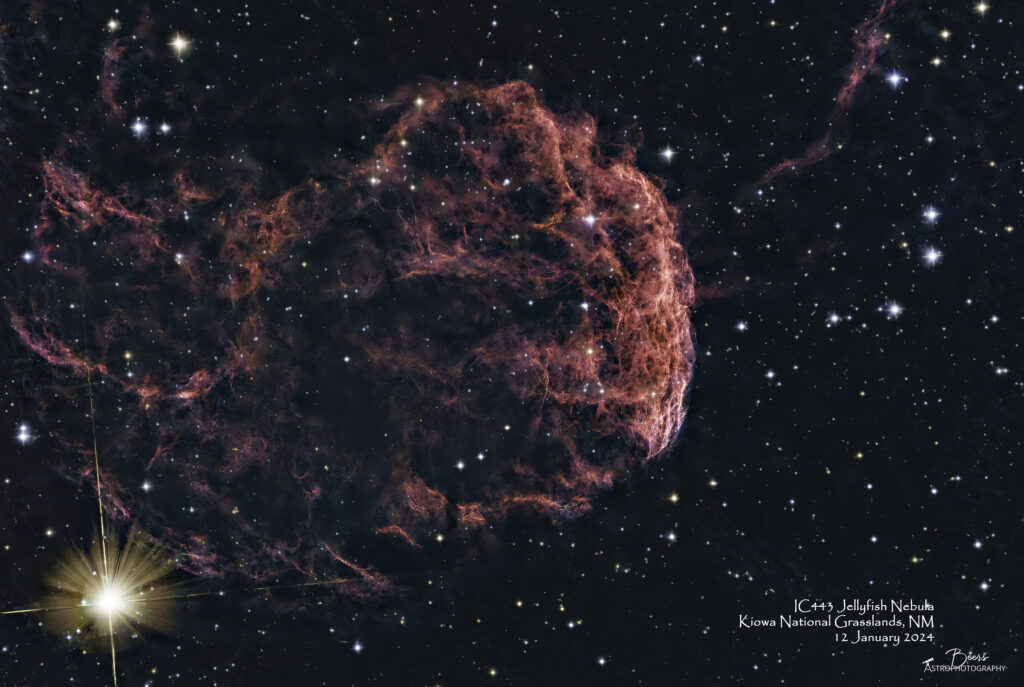
Capture Notes
During our one night in dark skies, I’d planned to image the Garlic Nebula until about midnight and then switch to the Jellyfish Nebula. I started out having issues plate solving on the Garlic, which turned out likely to be due to the power issue and lack of fully tightening the autoguide scope that I experienced with the collect throughout the night, but at the time I thought it was because of the wind and didn’t want to risk the 10-minute exposures in those conditions. So, I made the decision to collect data on IC443 Jellyfish Nebula all night long.
All night, turned out to end at 2300MST when I went out to do the meridian flip to find that the mount was locked up in RA. Lesson (re-)learned (or should I say learned after the situation was presented a second time?). You cannot power all the equipment (laptop, mount, and camera) from a single DC feed. I need to have a dedicated DC feed for the mount and use the second one for the laptop and camera. I first experienced this in January 2022 when the EQ-6R kept “freezing” in RA on the night’s second target when I had both BB on the EQ-6R and the Southern Cross running. At that point, I attributed it to temperature and the equipment really “freezing up” only to find – wasn’t the equipment freezing but the lack of sufficient power.
To park the mount (which was frozen in its pre-flip position – and the laptop was locked up), I had to connect the handset – that’s when I began to get the clue. The handset was beeping and displaying a flashing “Error in RA.” It took a few minutes for me to notice, it also said (in the flashing error message) “Voltage = 11.1V” At that point, I turned off the power to the laptop and camera – which raised the voltage error message to say 12.0V. That was still not enough to move the mount in RA more than a small fraction of the way it had to move before it would stop in error. So, I went into the Beast and turned on the motor – which charges the battery. That did the trick to allow me to get the mount parked!
That also gave me the confidence that perhaps I could continue the sequence. Wrong! On the first plate solve attempt, the mount didn’t move anywhere near the target and gave me an error that even the blind solving had failed because “it appears that the target is not in the frame.” At that point I decided a few more hours of data were not worth the price of ruining my new $9K mount…so I packed up the cabling (leaving the rest of the disassembly for the morning light) and went to bed.
Equipment
All equipment controlled by HP Probook running Sequence Generator Pro v4.2.0.1286.
- Imaging (ASI2400-BB-FF): ZWO ASI2400MC imaging camera with Teleskop Service Flattener 1.0x for RC Telescopes (TS-RCFLAT2); Orion 8″ f/8 Ritchey-Chretien Astrograph Telescope.
- Mount: Rainbow Astro RST-300 (controlled by iHubo ASCOM driver)
- Polar alignment: QHYCCD camera (controlled by Polemaster for polar alignment)
- Autoguiding: Orion 60mm Multi-Use Guide Scope with Orion StarShoot AutoGuider Pro Mono Astrophotography Camera (controlled by PHD2)
Sequence Plan
Gain 158, Offset 30, Temp 0°C; 69x3min. Captured 12Jan2024, 1901MST – 2304MST. Total exposure time: 3:27hrs.
4-session image (28Jan2022, 7Feb2023, 9Sep2023, and 11Nov2023)
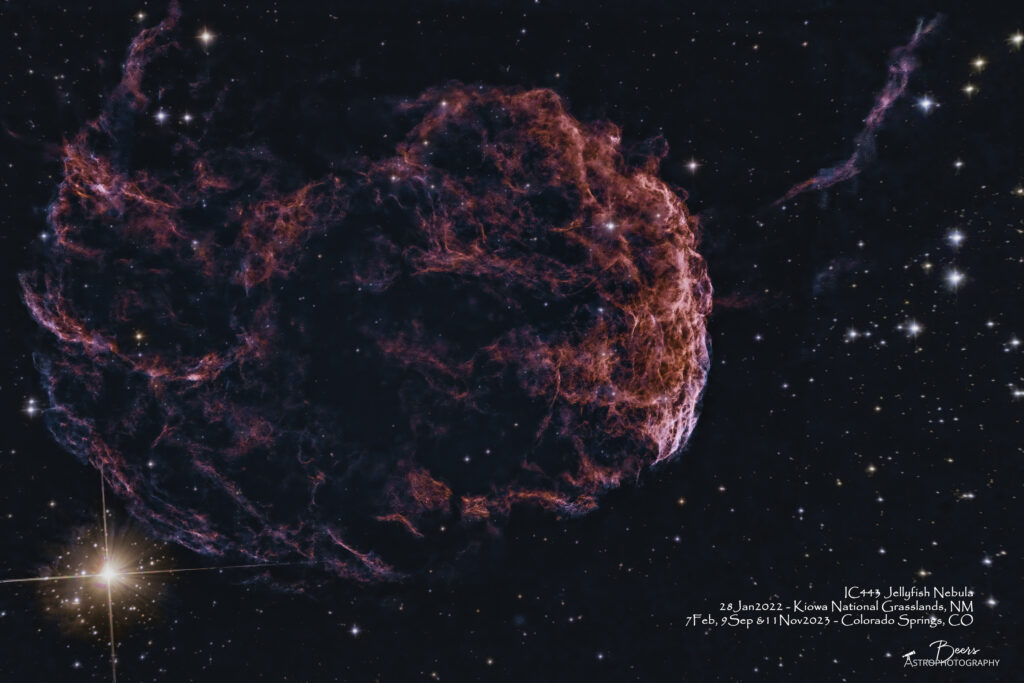
Capture Notes
Notes: This image is comprised of data captured during four separate imaging sessions. The sessions were 28Jan2022 with Big Bertha and the Canon EOS Ra (RaBB) in the dark skies of the Kiowa National Grasslands, NM. In 2023 on 7Feb2023 with the ZWO ASI2400MC, Big Zeus, and the LeX filter; 9Sep2023 ZWO ASI2400MC, Big Bertha, and the LeX filter; and 11Nov2023 with the ZWO ASI2400MC, Big Bertha, and the LPro filter. All the 2023 session were captured from HCH, Colorado Springs, CO.
Most of the individual images whose data comprises this image are shown below in the “other images of IC443 Jellyfish Nebula” section of this gallery.” With the exception of the most recent data set, captured on 11Nov2023. It turned out that my framing for that session was not correct, in that I didn’t include enough of the “plume” to contribute to the 3-session image’s (processed after collecting the 9Sep2023 data). Good to have learned that lesson during time on the front patio vs. discovering it after a night of imaging in dark skies! Thus the 4-session image was my priority in processing/posting rather than the 11 Nov 2023 data on its own (which I will likely get back to during the upcoming “Christmas break”)
Individual sessions’ Capture Notes:
28Jan2022: Captured, 28Jan2022 beginning at 1918MST at Kiowa National Grasslands, NM. Manual meridian flip at 2150. Completed 29Jan2022 at 0011. Equipment was Orion 8″ f/8 Ritchey-Chretien Astrograph Telescope, Sky-Watcher EQ6-R Pro Equatorial Mount, Orion 60mm Multi-Use Guide Scope, Orion StarShoot AutoGuider Pro Mono Astrophotography Camera, Canon EOS Ra.
7Feb2023: Second clear night of the week, the first after the arrival of the ZWO ASI2400MC. I was still waiting for the power cable to arrive, so I could run both the ASI2400MC and the RC-135E mount (i.e., image with the Askar FRA600, Southern Cross (SC)). As I was cursing the supply chain, I realized I had one power cord and the need for only one power cord, if I imaged with Big Zeus vs. the Southern Cross. So queued up the Jellyfish Nebula in SGP and executed first light with the ZWO ASI2400MC! It took a little bit to achieve focus, needing to add one of the 1” back focus rings into the imaging train (started with 2” that was too much, then took one off and the focusing worked well). I don’t fully understand the gain, offset, temperature and exposure settings. I had done some research of images from similar cameras on Telescopius. Most were taken at gain=100, temperature ranging from -10°C to +5°C, with 5 minute exposures. The initial 5 minute exposures looked pretty dark and the histogram seemed far to the left. So, when I came out to execute the meridian flip, I changed the exposure length to 10min for the rest of the night. After looking at the finished stacks, there wasn’t a huge difference between the 5 minute and 10 minute – with a bit more signal on the 10 minute. But decided to process the combined stack of 5+10minute subs, because the 10minute subframes did not include the star adjacent to IC443 (Propus), which I believe adds interest to the image (this could be reframed/recaptured with more of the star in the frame in the future).
9Sep2023: This was captured on Saturday night, 9Sep2023, the last clear night before a long wet, rainy, cloudy, stormy spell. The clouds were forecast (in the three different apps – WeatherUnderground, ClearOutside, and Astropheric) to clear up at either 2100 (WeatherUnderground), 0000 (Astropheric), or not at all (ClearOutside)! I went to bed at about 2100 with full cloud cover and set an alarm for 2330 – when I woke up there was a wisp of clouds, but I had hopes that the 0000 prediction was going to be correct, so got up and took the equipment outside and set up, and the process started. Started with NGC6979 Fleming’s Triangle with the intent to image it until it set at about 0330, then switch to the Jellyfish at about that time to begin gathering data on it until astronomical twilight ended at 0540…so this image is only about 1.5 hours of data – so definitely a place holder with the plan to gather more data on it as the fall/winter proceeds with more visibility.
11Nov2023: Although we cancelled the dark skies trip due to forecast clouds, we ended up having a clear night (on Friday that I didn’t take advantage of because it was forecast to cloud up at about 2300 – which it did NOT) on Saturday night, 11Nov2023. We have received the new ZWO Electronic Autofocuser (EAF) but have not done the mechanical to be able to attach it to Big Bertha yet. Paul will work on that while I’m at WPAFB for the SAB next week. Even without the EAF, I didn’t want to let a clear night with 1% waning moon go by. So, I set Big Bertha up on the front patio to spend the full night on IC443 Jellyfish Nebula. It turned out that the framing was not correct, in that I didn’t include enough of the “plume” to contribute to the 3-session image’s (processed after collecting the 9Sep2023 data). Good to have learned that lesson during time on the front patio vs. discovering it after a night of imaging in dark skies! Thus the 4-session image was my priority in processing rather than the 11 Nov 2023 data on its own (which I will likely get back to during the upcoming “Christmas break”)
Equipment
Equipment: All equipment controlled by HP Probook running Sequence Generator Pro
Imaging:
- RaBB (28Jan2022): Canon EOS Ra; Orion 8″ f/8 Ritchey-Chretien Astrograph Telescope
- ASI2400BZLeX (7Feb2023): ZWO ASI2400MC imaging camera with Teleskop Service Flattener 1.0x for RC Telescopes (TS-RCFLAT2) and Optolong L-Extreme LP filter; Orion 10″ f/8 Ritchey-Chretien Astrograph Telescope
- ASI2400BBLeX (9Sep2023): ZWO ASI2400MC imaging camera with Teleskop Service Flattener 1.0x for RC Telescopes (TS-RCFLAT2) and Optolong L-Extreme LP filter; Orion 8″ f/8 Ritchey-Chretien Astrograph Telescope
- ASI2400BBLPro (11Nov2023): ZWO ASI2400MC imaging camera with Teleskop Service Flattener 1.0x for RC Telescopes (TS-RCFLAT2) and Optolong L-Pro LP filter; Orion 8″ f/8 Ritchey-Chretien Astrograph Telescope
Mount: Sky-Watcher EQ6-R Pro Equatorial Mount (controlled by EQMOD)
Polar alignment: QHYCCD camera (controlled by Polemaster for polar alignment)
Autoguiding: Orion 60mm Multi-Use Guide Scope with Orion StarShoot AutoGuider Pro Mono Astrophotography Camera (controlled by PHD2);
Sequence Plans:
- Kiowa RaBB (28Jan2022): ISO1600; 50x5min + 10x2min (for Propus). Total exposure time: 4:30hrs. Captured, 28Jan2022 1918MST – 29Jan2022, 0011MST.
- HCH ASI2400MC#1 (First Light) BZ LeX (7Feb2023): Gain: 158, Temp: -0°C, no offset. 30x5min, 22x10min. Total exposure time: 6:10hrs. Captured 7Feb2023, 1927MST – 8Feb2023, 0128MST.
- HCH ASI2400MC#2 BB LeX (9Sep2023): Gain: 158, Temp: -0°C, offset=30; 19x5min. Total exposure time: 1:35hrs. Captured 9 September 2023 (10Sep2023, 0409MDT – 00547MDT).
- HCH ASI2400MC#2 BB LPro (11Nov2023): Gain: 158, Temp: -0°C, offset=30; 80x5min. Total exposure time: 6:40hrs. Captured 11 November 2023 (11Nov23, 2208MST – 12Nov23).
Total data included in image: 179x5min, 22x10min = 1,115min (18:35hrs)
Three-session image (28Jan2022, 7Feb2023, and 9Sep2023)
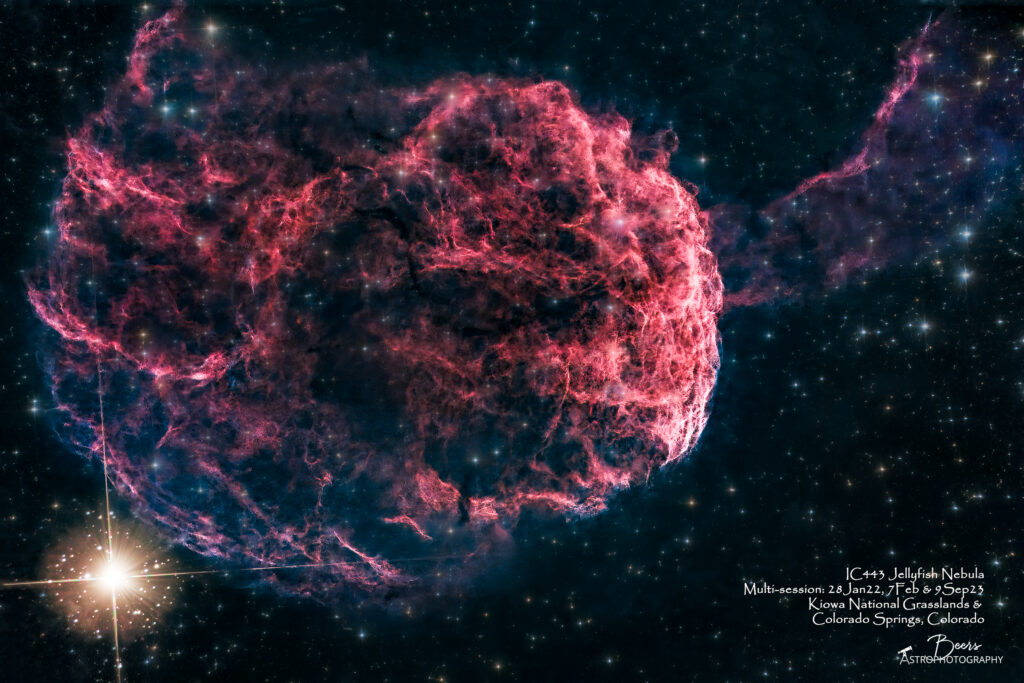
Notes: This three-session image is comprised of data captured in the three individual sessions described below – 28Jan2022 from Kiowa National Grasslands with RaBB, and the two images captured from the front patio: 7Feb2023 with ASI2400MC#1 on Big Zeus and 9Sep2023 with ASI2400MC#2 on Big Bertha. Once I captured, processed, and as I was posting the image I captured on Saturday night/Sunday morning (9-10Sep2023, with a paltry amount of data), I got to wondering what the result would look like if I stacked all the sessions together into a single image. This is that image. Combining the three images expanded the field-of-view (actually, the pallet) because of the very different framing that I used for each capture. The image directly below is the result of just the two images captured in 2023 (7Feb2023, 9Sep2023), and then the individual session images follow below.
BTW – I’m still considering these multi-session images as place-holders until I can gather a suitable amount of data on this target, that is framed correctly, and (please, please, please Mother Nature!) captured in dark skies!
Multi-session image from sessions:
Session (9Sep2023): Gain: 158, Temp: -0°C, offset=30; 19x5min. Total exposure time: 1:35hrs. Captured 9 September 2023 (10Sep2023, 0409MDT – 00547MDT). From: HCH, Colorado Springs, CO
Session (7Feb2023): Gain: 158, Temp: -0°C, no offset; 30x5min, 22x10min. Total exposure time: 6:10hrs. Captured 7Feb2023, 1927MST – 8Feb2023, 0128MST. From: HCH, Colorado Springs, CO
Session (28Jan2022) ISO1600; 50x5min + 10x2min (for Propus); Total exposure time: 4:10 hrs. Captured, 28Jan2022, 1918MST – 29Jan2022, 0011MST. From: Mills Canyon, Kiowa National Grasslands, New Mexico
Two-session image (7Feb2023 & 9Sep2023)

Notes: This image is a combination of the images captured in the two individual sessions shown and described below – the two images captured from the front patio: 7Feb2023 with ASI2400MC#1 on Big Zeus and 9Sep2023 with ASI2400MC#2 on Big Bertha. Once I captured, processed, and posted the image I captured on Saturday night/Sunday morning (9-10Sep2023, shown directly below) (with a paltry amount of data), I got to wondering what the result would look like if I stacked both the sessions together into a single image. The image above expands the pallet slightly (as opposed to the version from Big Zeus) to include Propus – the bright star shown in the NE corner of the image – that I believe brings an interesting touch to the image.
Multi-session image from sessions:
Session (9Sep2023): Gain: 158, Temp: -0°C, offset=30; 19x5min. Total exposure time: 1:35hrs. Captured 9 September 2023 (10Sep2023, 0409MDT – 00547MDT). From: HCH, Colorado Springs, CO
Session (7Feb2023): Gain: 158, Temp: -0°C, no offset; 30x5min, 22x10min. Total exposure time: 6:10hrs. Captured 7Feb2023, 1927MST – 8Feb2023, 0128MST. From: HCH, Colorado Springs, CO
Beginning the visibility season: 9 September 2023

Capture Notes: This image is definitely a place-holder for the start of the season when IC443 Jellyfish Nebula is becoming visible – for only a short period of time, rising early in the pre-dawn morning. This was captured on Saturday (9Sep2023) night, the last clear night before a long wet, rainy, cloudy, stormy spell. The clouds were forecast (in the three different apps – WeatherUnderground, ClearOutside, and Astropheric) to clear up at either 2100 (WeatherUnderground), 0000 (Astropheric), or not at all (ClearOutside)! I went to bed at about 2100 with full cloud cover and set an alarm for 2330 – when I woke up there was a wisp of clouds, but I had hopes that the 0000 prediction was going to be correct, so got up and took the equipment outside and set up, and the process started. Started the night with NGC6979 Fleming’s Triangle with the intent to image it until it set at about 0330, then switch to the Jellyfish at about that time to begin gathering data on it until astronomical twilight ended at 0540…so this image is only about 1.5 hours of data – so a place holder with the plan to gather more data on it as the fall/winter proceeds with more visibility.
Equipment
Polar alignment: QHYCCD camera (controlled by Polemaster)
Imaging stream: Orion 8″ f/8 Ritchey-Chretien Astrograph Telescope, ZWO ASI2400MC#2 imaging camera with Optolong L-Extreme LP filter.
Mount: Sky-Watcher EQ6-R Pro Equatorial Mount (controlled by EQMOD)
Autoguider: Orion 60mm Multi-Use Guide Scope, Orion StarShoot AutoGuider Pro Mono Astrophotography Camera (controlled by PHD2)
All equipment controlled by HP Probook (DSO CTRL 2) Windows 11 laptop running Sequence Generator Pro v4.2.0.16.
Sequence Plan
Sequence plan: Gain: 158, Temp: -0°C, offset=30; 19x5min. Total exposure time: 1:35hrs.
Capture: Captured 9 September 2023 (10Sep2023, 0409MDT – 00547MDT).
Shooting location: HCH, Colorado Springs, CO
First Light with ASI2400MC (on Big Zeus)
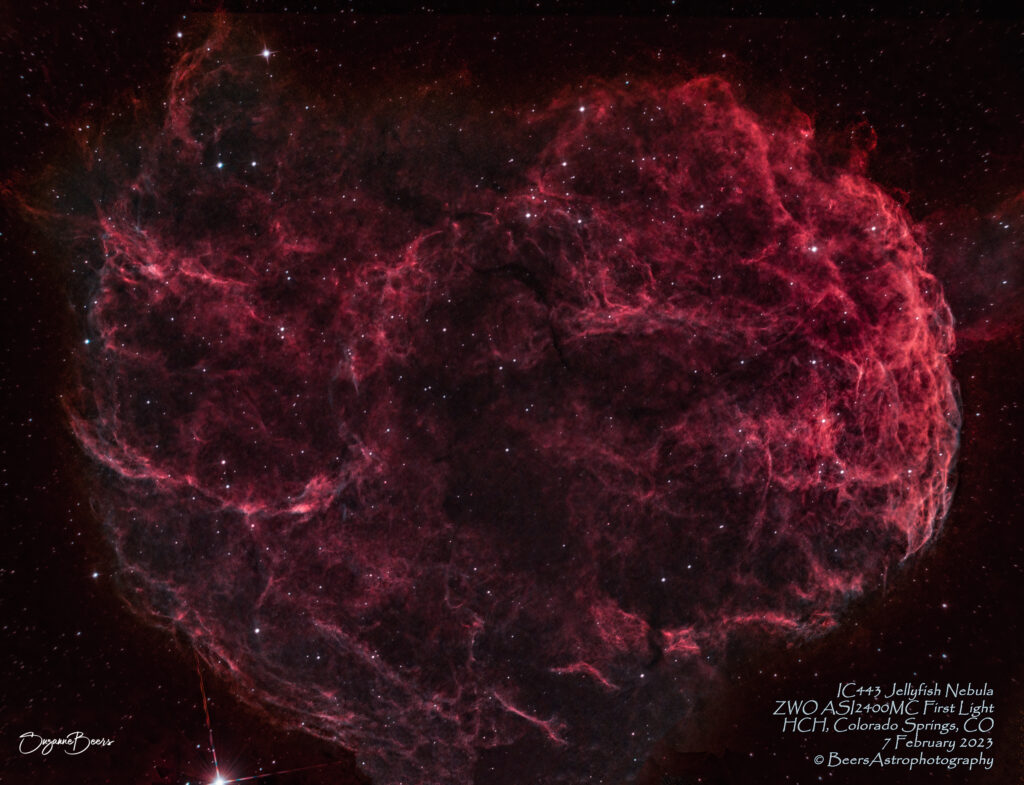
Capture Notes: First clear night after the arrival of the ZWO ASI2400MC. Was still waiting for the power cable to arrive, so I could run both the ASI2400MC and the RC-135E mount (i.e., image with the Askar FRA600, Southern Cross (SC)). Realized I had one power cord and the need for one power cord, if I imaged with Big Zeus vs. the Southern Cross, so queued up the Jellyfish Nebula in SGP and executed first light with the ZWO ASI2400MC. It took a little bit to achieve focus, needing to add one of the 1” back focus rings into the imaging train (started with 2” that was too much, then took one off and the focusing worked well). I don’t fully understand the gain, offset, temperature and exposure settings. I had done some research of images from similar cameras on Telescopius. Most were taken at gain=100, temperature ranging from -10°C to +5°C, with 5 minute exposures. The initial 5 minute exposures looked pretty dark and the histogram seemed far to the left. So, when I came out to execute the meridian flip changed the exposure length to 10min for the rest of the night. After looking at the finished stacks, there wasn’t a huge difference between the 5 minute and 10 minute – with a bit more signal on the 10 minute. But decided to process the combined stack of 5+10minute subs, because the 10minute subframes did not include the star adjacent to IC443, which I believe adds interest to the image (this could be reframed/recaptured with more of the star in the frame in the future).
Equipment
Polar alignment: QHYCCD camera (controlled by Polemaster)
Imaging stream: Orion 10″ f/8 Ritchey-Chretien Astrograph Telescope, ZWO ASI2400MC imaging camera with Teleskop Service Flattener 1.0x for RC Telescopes (TS-RCFLAT2) and Optolong L-Extreme LP filter.
Mount: Sky-Watcher EQ6-R Pro Equatorial Mount (controlled by EQMOD)
Autoguider: Orion 60mm Multi-Use Guide Scope, Orion StarShoot AutoGuider Pro Mono Astrophotography Camera (controlled by PHD2)
All equipment controlled by HP Probook running Sequence Generator Pro v3.2.0.660.
Sequence Plan
Sequence plan: Gain: 158, Temp: -0°C, no offset; 30x5min, 22x10min. Total exposure time: 6:10hrs.
Capture: Captured 7Feb2023, 1927MST – 8Feb2023, 0128MST
Shooting location: HCH, Colorado Springs, CO
Dark Skies – Kiowa National Grassland, New Mexico
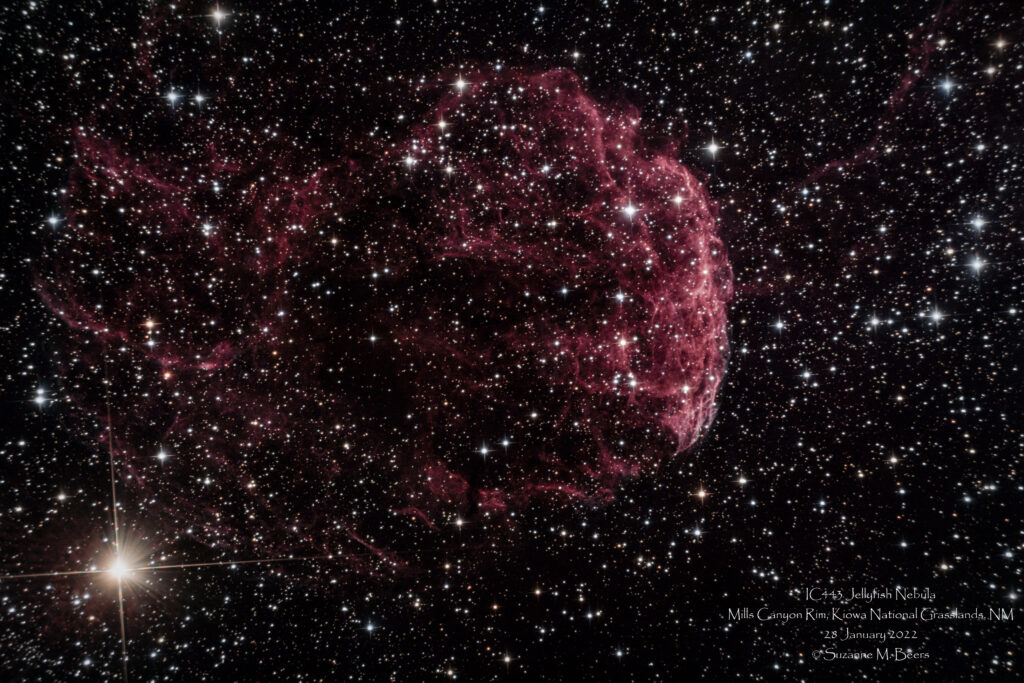
Capture Notes: This image was captured during a wildly successful, albeit cold (the Beast house battery drained and the control laptop shut down during the second target of the night (Cone Nebula)!), dark skies trip to the Kiowa National Grasslands of northeastern New Mexico.
Equipment
Polar alignment: QHYCCD camera (controlled by Polemaster)
Imaging stream: Orion 8″ f/8 Ritchey-Chretien Astrograph Telescope, Canon EOS Ra
Mount: Sky-Watcher EQ6-R Pro Equatorial Mount
Autoguider: Orion 60mm Multi-Use Guide Scope, Orion StarShoot AutoGuider Pro Mono Astrophotography Camera (controlled by PHD2)
All equipment controlled by HP Probook running Sequence Generator Pro v3.2.0.660.
Sequence Plan
Sequence plan: ISO1600; 50x5min + 10x2min (for Propus); Total exposure time: 4:10 hrs.
Capture: Captured, 28Jan2022, 1918MST – 29Jan2022, 0011MST
Shooting location: Mills Canyon, Kiowa National Grasslands, New Mexico
